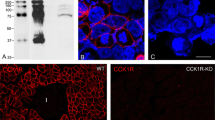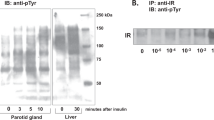Summary
The morphological and functional effects of tunicamycin were studied in rat parotid glands at the stage of the reformation of secretory granules following secretory stimulation by isoproterenol. Tunicamycin inhibited the incorporation of (3H)-mannose into the acid-insoluble fraction but had no effect on total protein synthesis as determined by the incorporation of (14C)-leucine. Thus the administration of tunicamycin in vivo inhibits the synthesis of mannose-rich glycoproteins in a manner similar to that in an in vitro system. The ultrastructure of the acinar cell showed little change following treatment with this drug, except that the number of reaccumulated secretory granules was greater than in the control. Amylase secretion stimulated by isoproterenol was inhibited in tunicamycin-treated cells, but did not decrease following treatment with N6,2′-O-dibutyryladenosine 3′-5′-cyclic monophosphate, a secretory stimulator bypassing the β-receptor. A radio-receptor assay using (3H)-dihydroalprenolol and direct localization using the fluorescent β-adrenergic blocker 9-amino-acridin propranolol showed a marked reduction in the binding activity of β-receptor following treatment with tunicamycin. Thus the inhibition of N-linked glycosylation appears to produce profound effects on the β-adrenergic receptor-adenylate cyclase complex of acinar cells, although the steps of the transport and the exocytotic discharge of secretory materials are not affected.
Similar content being viewed by others
References
Amsterdam A, Ohad I, Schramm M (1969) Dynamic changes in the ultrastructure of the acinar cells of the rat parotid gland during the secretory cycle. J Cell Biol 41:753–773
Babad H, Ben-Zvi R, Bdolah A, Schramm M (1967) The mechanism of enzyme secretion by the cell: 4. Effect of inducers, substrates, and inhibitors on amylase secretion by rat parotid slices. Eur J Biochem 1:96–101
Bernfeld P (1955) In: Colowick SP, Kaplan NA (eds) Methods in enzymology. Academic Press, New York, 1, pp 149–150
Butcher FR, Goldman JA, Nemerovski M (1975) Effect of adrenergic agents on α-amylase release and adenosine 3′,5′-monophosphate accumulation in rat parotid tissue slices. Biochim Biophys Acta 392:82–94
Byland DB, Martinez J, Camden J, Jones SB (1982) Autonomic receptors in the developing submandibular glands of neonatal rats. Arch Oral Biol 27:945–950
Byrt P (1966) Secretion and synthesis of amylase in the rat parotid gland after isoprenaline. Nature 212:1212–1215
Dorthea A, Johnson MS, Sreebny LM (1973) Effect of isoproterenol on synthesis and secretion in the rat parotid gland. Lab Invest 28:263–269
Doss RC, Kramarcy NR, Harden TK, Perkins JP (1985) Effects of tunicamycin on the expression of β-adrenergic receptors in human astrocytoma-cells during growth and recovery from agonist-induced down-regulation. Mol Pharmacol 27:507–516
Duksin D, Bornstein P (1977) Changes in surface properties of normal and transformed cells caused by tunicamycin, an inhibitor of protein glycosylation. Proc Natl Acad Sci USA 74:3433–3437
Evans GH, Nies AS, Shand DG (1973) The disposition of propranolol: III. Decreased half-life and volume of distribution as a result of plasma binding in man, monkey, dog and rat. J Pharmacol Exp Ther 186:114–122
Gonzalez CB, Swann RW, Pickering BT (1981) Effect of tunicamycin on the hypothalamo-neurohypophysial system of the rat. Cell Tissue Res 217:199–210
Heifetz A, Keenan RW, Elbein AD (1979) Mechanism of action of tunicamycin on the UDP-GlcNAc: Dolichyl-phosphate GlcNAc-1-phosphate transferase. Bicohemistry 18:2187–2192
Hertting G (1964) The fate of 3H-iso-proterenol in the rat. Biochem Pharmacol 13:1119–1128
Kornfeld R, Kornfeld S (1980) In: Lennarz WJ (ed) The biochemistry of glycoproteins and proteoglycans. Plenum Press, New-York, pp 1–34
Kousvelari EE, Grant SR, Baum BJ (1983) β-adrenergic receptor regulation of N-linked protein glycosylation in rat parotid acinar cells. Proc Natl Acad Sci USA 80:7146–7150
Kuo SC, Lampen JO (1974) Tunicamycin — an inhibitor of yeast glycoprotein synthesis. Biochem Biophys Res Commun 58:287–295
Lillie JH, Han SS (1973) Secretory protein synthesis in the stimulated rat parotid gland: temporal dissociation of the maximal response from secretion. J Cell Biol 59:708–721
Melamed E, Lahav M (1976) Direct localization of β-adrenoceptor sites in rat cerebellum by a new fluorescent analogue of propranolol. Nature 261:420–421
Michaels JE (1980) Alterations in the distribution of glycoproteins in epithelial cells of murine colon after injection of tunicamycin. Cell Tissue Res 210:121–132
Olden K, Pratt RM, Yamada KM (1978) Role of carbohydrates in protein secretion and turnover: effects of tunicamycin on the major cell surface glycoproteins of chick embryo fibroblast. Cell 13:461–473
Rosen OM, Chia GH, Fung C, Rubin CS (1979) Tunicamycin-mediated depletion of insulin receptors in 3T3-L1 adipocytes. J Cell Physiol 99:37–42
Rosenthal HE (1967) A graphic method for the determination and presentation of binding parameters in a complex system. Anal Biochem 20:525–532
Sarras MP, Maylié-Pfenninger MF, Manzi RM, Jamieson JD (1981) The effect of tunicamycin on development of the mammalian embryonic pancreas. Dev Biol 87:1–15
Schramm M, Naim E (1970) Adenyl cyclase of rat parotid gland: activation by fluoride and norepinephrine. J Biol Chem 245:3225–3231
Simson JV (1969) Discharge and restitution of secretory material in the rat parotid gland in response to isoproterenol. Z Zellforsch 101:175–191
Stadel JM, Strulovici B, Nambi P, Lavin TN, Briggs MM, Caron MG, Lefkowitz RJ (1983) Desensitization of the β-adrenergic receptor of frog erythrocytes: recovery and characterization of the down regulated receptors in sequestered vesicles. J Biol Chem 258:3032–3038
Stiles GL, Benovic JL, Caron MG, Lefkowitz RJ (1984) Mammalian β-adrenergic receptors: distinct glycoprotein populations containing high mannose or complex type carbohydrate chains. J Biol Chem 259:8655–8663
Su YF, Harden TK, Perkins JP (1980) Catecholamine-specific desensitization of adenylate cyclase: evidence for a multistep process. J Biol Chem 255:7410–7419
Tkacz JS, Lampen JO (1975) Tunicamycin inhibition of polyisoprenyl N-acetylglucosaminyl pyrophosphate formation of calf liver microsomes. Biochem Biophys Res Commun 65:248–257
Author information
Authors and Affiliations
Rights and permissions
About this article
Cite this article
Tamaki, H., Yamashina, S. In vivo effects of tunicamycin on the secretory processes of rat parotid glands. Cell Tissue Res. 250, 323–330 (1987). https://doi.org/10.1007/BF00219077
Accepted:
Issue Date:
DOI: https://doi.org/10.1007/BF00219077




